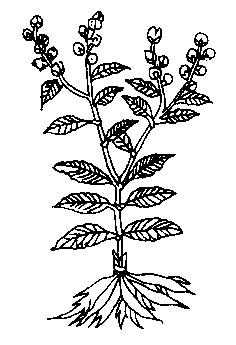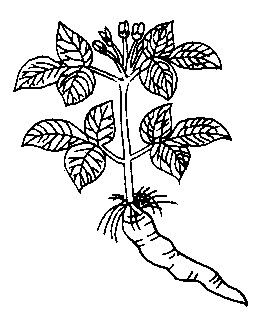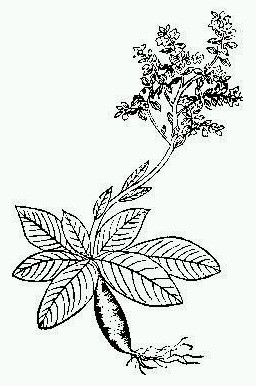| title | Scrophularia Root |
| release time | 2006/8/20 |
| source | Jade Knock Studio |
Scrophularia Root is the dried root of Scrophularia ningpoensis Hemsl., a plant of the Scrophulariaceae family. Scrophularia Root is mainly produced in Dongyang, Xianju, Pan'an, Jinyun, Lin'an, Fuyang, and Tonglu in Zhejiang Province, as well as in Sichuan, Shaanxi, Guizhou, Hunan, Hubei, Jiangxi, Shandong, Hebei, Henan, and Shanxi provinces. Scrophularia Root is one of the famous "Zhejiang Eight Herbs," with the Zhejiang-produced variety being considered the most authentic.
Materia medica research suggests that the medicinal use of Scrophularia Root has always been dominated by plants of the Scrophularia genus in the Scrophulariaceae family. The Bencao Gangmu mentions that Scrophularia Root has "flowers of two colors, purple and white," with the purple-flowered variety likely being the Scrophularia ningpoensis used today. Scrophularia Root is produced in both the north and south, but its status as a genuine regional materia medica in Zhejiang likely began during the Republic of China era.
bubble_chart Varietal Identification
The Guangya Shicao states: "Deer intestine is Scrophularia Root." The Bencao Jing names it "Chongtai," while the Bielu lists names such as Xuantai, Deer Intestine, Zhengma, Xian, and Duan. The Taiping Yulan, Volume 991, quotes the Wu Pu materia medica, which provides a detailed description of Scrophularia Root's morphology: "Scrophularia Root is also known as Guizang, Zhengma, Chongtai, Deer Belly, Duan, and Xuantai. Shennong, Tongjun, Huangdi, Leigong, and Bian Que describe it as bitter and non-toxic. Qibo describes it as salty. Li Shi describes it as cold. It may grow on the sunny side of Wanjushan. It sprouts in February, with leaves resembling plum leaves (with) hairs, arranged in pairs, similar to Peony Root, with black stems, square stems, reaching a height of four to five feet, red flowers growing between branches, and black fruits in April." The phrase "leaves resembling plum hairs" is suspected to mean "leaves resembling plum leaves with hairs." From the description, it seems closer to Scrophularia moellendorffii Maxim. and Scrophularia buergeriana Miq. of the Scrophulariaceae family, while the alias "Chongtai" seems to describe the sparse terminal spike inflorescence of Scrophularia moellendorffii.
Tao Hongjing's description of Scrophularia Root is quite perplexing. The Jizhu states: "Now found near roads, it is everywhere. The stem resembles Ginseng but is longer and larger, the root is very black, and it has a slight fragrance. Taoists occasionally use it, also for blending incense."The plant Scrophularia Root bears no resemblance to Ginseng of the Araliaceae family, hence Su Jing criticized: "The root and seedling of Scrophularia Root both have a foul smell, and its stem does not resemble Ginseng. Tao mentioned that Taoists also use it for blending incense, but the rationale behind this is unclear." However, was the medicinal Scrophularia Root in Tao Hong-jing's era a different entity, or was there another reason? According to the newly revised "Maoshan Zhi" in the 1990s, the reserves of Scrophularia Root in the Maoshan area of Jurong range between 100-2500 kg, which proves that Scrophularia Root plants of the Scrophularia genus are indeed distributed in Maoshan. Therefore, Tao's statement that "it is now found everywhere near the roads" should be reasonable; the so-called "used by Taoists at times" might refer to the story in "Liexian Zhuan" where a man from Longxi, Shan Tu, broke his foot by stepping on a horse, and a Taoist in the mountains taught him to take Rehmannia, Chinese Angelica, Notopterygium, and Scrophularia Root (see "Chuxue Ji", the Taoist canon version of "Liexian Zhuan" mentions taking Rehmannia, Chinese Angelica, Notopterygium, Pubescent Angelica, and Sophora powder). As for blending incense with Scrophularia Root, Bencao Tujing details the method: "Tao Yin-ju said that Taoists sometimes use it for blending incense, and now people have passed down the method. Grind Scrophularia Root and Chinese nardostachys root and rhizome separately into powder, weigh them equally, place them in a large wine bottle, add white honey to soak, fill the bottle to seven or eight parts, tightly seal the top, place it in a cauldron, boil without stopping the fire, stop the fire after one period, wait for it to cool, break the bottle to take out, grind again until smooth, if dry, add more cooked honey, store in a porcelain vessel, bury it in the ground, take out as needed, add borneol, and it can also be used to scent clothes." As for Tao's statement that Scrophularia Root "resembles Ginseng in stem", Mori Tachiyuki's explanation makes the most sense: "Judging from this statement, it is also evidence that Tao had not seen the true Ginseng plant." That is, Tao Hong-jing mistakenly said so because he had not seen the original plant of Ginseng of the Araliaceae family, not that Scrophularia Root truly resembles Ginseng.
The Scrophularia Root described in Song Dynasty literature are all plants of the Scrophularia genus. The Kaibao Bencao states: "The stem is square and large, four to five feet tall, purple-red with fine hairs, and the leaves are as large as a palm and pointed. The roots are greenish-white when fresh and turn purple-black when dried." The Bencao Tujing states: "It sprouts in February. The leaves resemble sesame and also resemble those of the locust and willow trees, with slender stems that are greenish-purple. It blooms with greenish-blue flowers in July and bears black seeds in August. There is also a variety with white flowers, with square and large stems, purple-red with fine hairs, and nodes like bamboo, reaching five to six feet in height. The leaves are as large as a palm, pointed, and serrated like a saw. The roots are pointed and long, greenish-white when fresh, turning purple-black when dried, and are moist and smooth when fresh. One root can produce five to seven shoots, and it is harvested and dried in March, August, and September." The variety with black roots, square stems, hairy texture, and greenish-blue flowers is likely the northern Scrophularia Root, Scrophularia buergeriana, while the variety with white flowers is probably another species within the same genus. It was not until the Bencao Gangmu that it was stated that Scrophularia Root has "flowers of two colors, purple and white," with the purple-flowered variety likely being the Scrophularia ningpoensis used today.After the Song Dynasty, the varieties of Scrophularia Root likely did not change, but there are some points to clarify regarding its medicinal illustrations. The Zheng Lei depicts three types of Scrophularia Root, among which the Hengzhou Scrophularia Root is undoubtedly a plant of the Scrophularia genus (Figure 1). However, the Jiangzhou Scrophularia Root and Xingzhou Scrophularia Root illustrations clearly do not depict plants of the Scrophularia family. The Jiangzhou Scrophularia Root (Figure 2) in particular may have been a counterfeit product influenced by Tao Hongjing's misleading statement that Scrophularia Root "has stems resembling Ginseng." The Ming Dynasty Bencao Pinhui Jingyao copied the three illustrations from the Zheng Lei without any innovation, while the Bencao Mengquan only adopted the Jiangzhou Scrophularia Root illustration with slight embellishments, suggesting that the authors of these books had never actually seen Scrophularia Root. The Jinling edition of the Bencao Gangmu used the Hengzhou Scrophularia Root illustration from the Zheng Lei. Although the depiction was somewhat inaccurate, it was not entirely wrong. However, the Zhang Shaotang edition replaced it with the Scrophularia Root illustration from the Zhiwu Mingshi Tukao, which was a significant error. As for the Tukao, its entry on Scrophularia Root is very brief, stating only: "Scrophularia Root, a middle-grade herb in the Benjing, with detailed descriptions in the Song Dynasty Bencao Tujing, comes in two varieties with purple and white flowers." However, its illustration was mistakenly drawn as a plant of the Rehmannia genus, Rehmannia glutinosa Libosch. (Figure 3). It is unclear whether this was due to Wu Qijun's misidentification of Scrophularia Root or an error in the engraving process by Lu Yinggu after Wu's death.



bubble_chart Historical Evolution of Authentic Sources
The Bencao Jing and Bielu state that Scrophularia Root "grows in the river valleys of Hejian and Yuanju." The Taiping Yulan quotes the Jiankang Ji as saying, "Jiankang produces Scrophularia Root," which is the earliest record of Scrophularia Root being produced in the south. Jiankang, now known as Nanjing, strongly corroborates Tao Hongjing's statement that "now it is found near the roads, everywhere." During the Tang Dynasty, the production of Scrophularia Root was still primarily in the north. The Qianjin Yifang's "Records of Medicinal Products from Various Regions" mentions that Huazhou produces Scrophularia Root, which aligns with the Fanzi Jiran's statement that "Scrophularia Root comes from the Sanfu region, and the green variety is the best." Although the Taiping Huanyu Ji was completed in the Song Dynasty, its records mainly reflect the situation during the Tang Dynasty. According to it, Henan Prefecture had Scrophularia Root as a tribute item. In the Song Dynasty, Su Song said, "Now it is found everywhere," but according to the medicinal illustrations, it was found in Hengzhou, Xingzhou, and Jiangzhou. Since the varieties of Scrophularia Root depicted in Xingzhou and Jiangzhou were different, the production areas could not be definitively counted.
Southern Song local chronicles that mention the local product Scrophularia Root include "Xin'an Zhi," "Chicheng Zhi," and "Jingding Jiankang Zhi," corresponding to present-day Huizhou in Anhui, Taizhou in Zhejiang, and Nanjing in Jiangsu. According to the "Ming Yitong Zhi," both Hezhou and Jiujiang Prefecture produced Scrophularia Root, which are today's He County in Anhui and Jiujiang in Jiangxi. Although "Chicheng Zhi" records that Scrophularia Root was produced on Tiantai Mountain in Taizhou, which can be seen as the precursor to later Zhejiang-produced Scrophularia Root, the formation of Zhejiang's reputation for authentic Scrophularia Root likely did not occur until the Republican era. "The Identification of Medicinal Products" mentions "produced in Hangzhou Prefecture, Zhejiang," but the "Regulations of the Medicinal Trade Association of Xijing City (Xi'an), Shaanxi" from 1940 still states: "Scrophularia Root is produced everywhere in the wild, with Sichuan producing the most." This indicates that Zhejiang Scrophularia Root had not yet gained nationwide popularity at that time.




